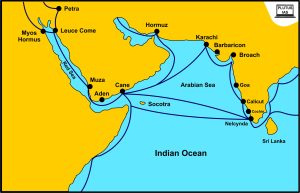14 Sep Ancient Red Sea Trade Route
This article covers “Daily Current Affairs” and the Topic details “Ancient Red Sea Trade Route”. This Topic has relevance in the Ancient History section of the UPSC CSE exam.
For Prelims:
About the Ancient Red Sea Trade Route?
For Mains:
GS 1: Ancient History
Significance of Ancient History?
Why in the news:
The India-Middle East-Europe Economic Corridor, unveiled during the G20 Summit, evokes the historical trade route that once connected the Indian subcontinent with the Roman Empire.
Recognition of Ancient Red Sea Trade Route:
- Historians have long acknowledged the existence of trade between Rome and India in ancient times.
- Sir Mortimer Wheeler’s excavations during the 1930s and 40s at Arikamedu, near modern-day Pondicherry, provided concrete evidence of Indo-Roman trade during the 1st century CE.

Underappreciation of Indian Merchants and Ship Owners:
- Indian merchants and ship owners played a pivotal role in this historical exchange. Unfortunately, their contributions have often been overlooked in historical accounts.
Immense Scale of the Trade:
- Recent revelations have shed light on the enormous scale of this trade route. Current estimates indicate that custom taxes from Red Sea trade with India, Persia, and Ethiopia accounted for up to one-third of the Roman exchequer’s income.
Source of Revelation:
- The remarkable insight into the trade’s magnitude comes from the Muziris Papyrus. This document was authored by an Egypto-Roman financier based in Alexandria and provides details about goods obtained from an Indian merchant located in distant Muziris, situated on the Kerala coast.
Economic Impact on the Roman Empire:
- The Muziris Papyrus reveals import taxes exceeding two million sesterces on cargo valued at nearly nine million sesterces.
- Indian imports into Egypt by the 1st century CE may have surpassed a billion sesterces annually, significantly bolstering the Roman Empire’s finances.
- These revenues were vital for sustaining the vast Roman Empire, surpassing the incomes of entire subjugated nations.
Trade Commodities on the Red Sea Route:
- Luxuries from India, including malabathrum (similar to cinnamon), ivory, pearls, gemstones, and especially pepper, were highly sought after throughout the Roman Empire.
- Indian pepper, in particular, became a staple, appearing in approximately 80% of the recipes found in the Roman cookbook of Apicius.
- In the opposite direction, trade involved the export of gold to India, leading to a trade imbalance.
- Historical records also suggest that Indians developed a taste for Roman wine.
Organization and Duration of the Trade:
- Agreements between merchants from Kerala and shippers from Alexandria suggest the existence of a well-organized trade network.
- Goods were transported in containers resembling modern cargo vessels.
- Indian mariners skillfully harnessed monsoon winds, allowing for a journey of six to eight weeks from India to Egypt.
Indian Involvement in the Trade:
- Indians, including dynasties, showed a keen interest in seafaring. Indian sailors left their mark in locations such as the Hoq caves on the Socotra island, highlighting their active participation in the trade.
Red Sea Trade vs. Silk Road:
- Contrary to contemporary perceptions, the Red Sea trade route during the Roman era held greater historical importance than the Silk Road.
- The concept of the Silk Road, as we understand it today, did not exist in ancient times, and interactions between China and Europe were limited.
Ongoing discoveries continue to shed light on the significance of the Red Sea trade route. Questions about India’s impact during this period, its role in global trade, and its influence on ideas remain open. While Indian scholars have made substantial contributions to this field, efforts to disseminate these findings more broadly are essential for a deeper understanding of history.
Download plutus ias current affairs eng med 14th Sep 2023
Q.1 Consider the following statements about Arikamedu:
- Arikamedu is an archaeological site near Pondicherry that has revealed evidence of Indo-Roman trade during the 1st century CE.
- Sir Mortimer Wheeler conducted the excavations at Arikamedu.
- Arikamedu was a major centre for bead production.
How many of the above pairs are correctly matched?
(a) Only one
(b) Only two
(c) All three
(d) None
Q.2 Consider the following statements about the Ancient Red Sea Trade Route:
- The Ancient Red Sea Trade Route was a significant trade link between Rome and India in ancient times.
- Custom taxes from the Red Sea trade with India, Persia, and Ethiopia accounted for up to one-third of the Roman exchequer’s income.
Which of the statements given above is/are correct?
(a) 1 only
(b) 2 only
(c) Both 1 and 2
(d) Neither 1 nor 2
Q.3 The Ancient Red Sea Trade Route was a significant link between Rome and India. Comment.




No Comments